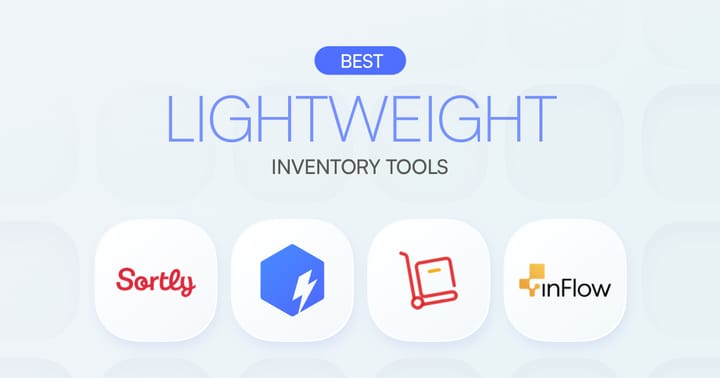Warehouse Management System (WMS) Explained: What You Need to Know

In 2025, running a warehouse is getting harder. Customers want their orders delivered faster, and they expect to know what’s in stock at any given moment. It’s tough to keep up with all that if you’re still doing everything by hand.
Managing inventory has gotten more complicated, with businesses managing inventory across multiple locations, dealing with several suppliers, and fulfilling orders through multiple channels. To stay organized, more and more businesses–both big and small–are turning to warehouse management systems (WMS).
In this guide, we'll explore what a warehouse management system is, how it works, its key features, types, benefits, and how to choose the best one for your business in 2025.
What Is a Warehouse Management System?
A warehouse management system (WMS) is specialized software designed to optimize and manage day-to-day warehouse operations. It provides a central platform for controlling inventory movement, processing orders, managing warehouse space, and coordinating resources within a warehouse or distribution center.
A WMS helps businesses answer critical questions like:
• Where is it located?
• How should we pick, pack, and ship it most efficiently?
• How can we optimize warehouse space?
The system provides real-time visibility and control over these operations, enabling businesses to make data-driven decisions.
Modern WMS systems have evolved from basic inventory tracking tools to sophisticated platforms that can integrate with enterprise resource planning (ERP) systems, transportation management systems (TMS), and even robotics and automation equipment. This evolution has made WMS an indispensable part of the modern supply chain technology stack.
How Does a WMS Work?
A warehouse management system works by integrating various warehouse activities into one centralized platform. Here are the key functions that define how a modern WMS operates:
1. Inventory Tracking and Management
A WMS provides real-time visibility into inventory levels, locations, and movements. The system offers live inventory tracking that allows you to monitor items from any location, easily visualize each item, and search inventory using custom attributes for quantity, cost, manufacturer, SKUs, and more.
Related: What's a Stock Keeping Unit (SKU)?
2. Order Processing and Fulfillment
The system manages the entire order fulfillment process, from receiving customer orders to picking, packing, and shipping. It prioritizes orders, creates pick lists, and provides instructions to warehouse staff for efficient order fulfillment.
3. Receiving and Putaway
When new inventory arrives, a WMS guides the receiving process, including quality checks, barcode scanning, and determining the best storage location.
BoxHero, a cloud-based WMS designed for small to mid-sized businesses, includes barcode scanning tools that help maintain accuracy. With BoxHero, you can quickly scan products and track their movement across the supply chain using a Bluetooth scanner or even a smartphone camera.
4. Picking and Packing
WMS systems optimize the picking process by creating efficient pick paths, implementing batch picking, and reducing travel time for warehouse staff. This significantly speeds up order fulfillment and reduces labor costs.
5. Shipping and Transportation
A WMS coordinates with shipping carriers, prints shipping labels, and provides tracking information. Some systems also help optimize transportation routes and carrier selection.
6. Barcode & RFID Integration
Modern WMS solutions integrate with barcode scanners and RFID technology for accurate tracking. The best WMS systems offer mobile scanning capabilities that improve the speed and accuracy of stock handling while reducing manual errors.

7. Reporting and Analytics
Comprehensive analytics provide insights into warehouse performance, inventory turnover, order accuracy, and labor productivity. A well-designed WMS not only tracks these metrics but also presents them in a way that supports better decision-making.
BoxHero, for instance, includes an Analytics feature that brings all inventory data into a single, easy-to-understand table to help inform business decisions and improve forecasting.
8. Mobile Access
Modern WMS solutions also offer mobile apps that allow warehouse staff to access the system from anywhere in the facility using handheld devices. This way, you can manage inventory on the go, whether adding new inventory, monitoring shipments, or moving items between warehouses.

9. Low Stock Alerts
Advanced WMS systems also provide automatic notifications when inventory reaches predefined thresholds, helping you avoid stockouts and maintain optimal inventory levels.
Types of Warehouse Management Systems
Warehouse management systems come in various forms, each with its strengths and limitations. Understanding the different types can help you choose the most suitable solution for your business needs.
1. Standalone WMS
A standalone WMS focuses exclusively on warehouse operations without direct integration with other business systems. It's often used by businesses that require specialized warehouse functionality beyond what their existing systems provide.
Pros:
• Can often integrate with existing systems
• Usually feature-rich for warehouse operations
Cons:
• Potential data synchronization issues
• Additional software to maintain
2. Cloud-Based WMS
Cloud-based systems like BoxHero are hosted on remote servers and accessed via the internet. They offer flexibility, scalability, and lower upfront costs compared to on-premises solutions.
Pros:
• Automatic updates and maintenance
• Accessible from anywhere
• Easy scalability
• Faster implementation
Cons:
• Internet dependency
Examples:
3. Integrated WMS (with ERP/CRM)
These systems are built into larger enterprise software packages, connecting warehouse operations directly with other business functions.
Pros:
• Single system to manage and learn
• Consistent user interface
Cons:
• Often more expensive than standalone options
• Less flexibility to change individual components
4. On-Premises WMS
Traditional on-premises systems are installed and run on the company's local hardware and infrastructure.
Pros:
• One-time licensing fee (though maintenance costs continue)
• No internet dependency
• Potential for deeper customization
Cons:
• Responsibility for maintenance and updates
• Limited accessibility from outside the facility
• More IT resources required
Examples:
In 2025, cloud-based WMS solutions have become the dominant choice for most businesses due to their flexibility, scalability, and low entry barriers. However, the best choice depends on your specific business requirements, existing tech stack, and long-term goals.
Benefits of Using a Warehouse Management System in 2025
Implementing a WMS offers numerous advantages that can transform how your warehouse runs day to day:
1. Improved Inventory Accuracy
Real-time tracking and barcode scanning allow you to always know what’s in stock, what’s missing, and what needs restocking—without manual errors.
2. Get Things Done Faster
Instead of handling one order at a time, a tool like BoxHero lets your team process several orders in one go. With features like batch picking and smart suggestions, orders can move faster, saving time and helping you ship faster.
3. Lower Labor Costs
Because many routine processes are automated with a WMS, your team can handle more work (with fewer resources). Staff can focus on valuable tasks that actually move the business forward, rather than manual data entry.
4. Better Use of Space
A WMS helps you organize your warehouse layout to reduce walking time and maximize space. By analyzing your data, the system recommends ways to make better storage decisions.

5. Improved Customer Experience
Faster, more accurate order fulfillment means fewer delays and mistakes. Customers get what they ordered on time, which leads to repeat business.
6. Smart Cost Control
Avoid wasting money on excess stock or missed sales due to shortages. A WMS helps you strike a perfect balance, reducing waste and cutting down on unnecessary expenses.
7. Scalability and Cloud Benefits
Whether you’re managing one storage room or expanding into multiple warehouses, a good WMS grows with your business. You don’t need to install servers or hire IT staff—just log in and manage everything from anywhere. This is particularly important for small businesses experiencing rapid growth.
8. Better Data for Decision Making
With built-in analytics, you’ll spot trends, track KPIs, and identify what’s working (and what’s not). According to Markets and Markets, a good WMS helps businesses better predict what products they'll need, make smarter choices, and track item movement without the usual headaches.
9. Multi-Location Management
One dashboard. Multiple warehouses. You get a multi-location logistics management feature that helps track stock levels at each facility and control inventory flow when transferring stock between locations.
How to Choose the Best Warehouse Management System for Your Business
Selecting the right WMS is a big decision that can impact how your warehouse runs now and in the years ahead. Here's a step-by-step way to finding a system that fits your business:
1. Assess Your Business Size and Needs
Every business has different requirements based on its size, industry, and warehouse setup. Start by outlining your warehouse structure, inventory volume, order frequency, and team size. Small businesses may only need basic tracking, while larger operations could require multi-location support and more advanced features.
2. Identify Must-Have Features
Create a list of features your WMS must have, such as:
• Order management: Processing, picking, packing, shipping
• Integrations: ERP, e-commerce platforms, shipping carriers, accounting software
• Mobile functionality: Barcode scanning, mobile access for warehouse staff
• Reporting and analytics: Performance metrics, inventory reports, labor productivity
• User-friendliness: Intuitive interface, ease of training
• Scalability: Room to grow with your business
• Stock alerts: Notifications for low stock and automated reorder options
3. Consider Implementation and Training
Some systems are more complex to set up than others. Consider the following:
- How long will the implementation take?
- What kind of training is required?
- Does the vendor provide implementation support?
- How will you migrate existing data?
Cloud-based solutions tend to roll out faster and require less IT support, which can make the process easier for smaller teams.
4. Evaluate Total Cost of Ownership
Look beyond the initial price tag to understand the full picture:
• Setup costs: Data migration, configuration, customization
• Hardware: Servers, scanners, network equipment
• Ongoing support: Maintenance, software updates, training
• Potential R.O.I.: Time saved, reduced errors, better customer service
BoxHero, for example, offers a free plan for businesses with under 100 items and affordable monthly plans for larger inventories. The pricing is transparent, so there’s no surprises!
5. Check Integration Options
Your WMS should connect easily with your existing technology stack:
- ERP: For centralized business management
- E-commerce: For online order management
- Shipping: For labeling and tracking
- Accounting: For financial synchronization
- CRM: For linking customer data
6. Plan for the Future
Technology and business needs evolve rapidly. Look for a system that can grow with you:
- Does the system support new tech like AI, IoT, or machine learning?
- How frequently is the software updated with new features?
- Can it handle international sales or new warehouse locations?
Cloud-based solutions like BoxHero often have an advantage here, with regular updates that add new features and capabilities–no extra work on your end!
By taking the time to answer these questions, you’ll be able to narrow down your options and choose a WMS that best aligns with your business today and supports your growth tomorrow.
Best Practices for Warehouse Software Implementation
Successfully implementing a warehouse management system requires careful planning and execution. Following these key practices will ensure a smooth transition:
▶︎ Planning Phase
Start by defining clear objectives—whether improving inventory accuracy, speeding fulfillment, or reducing costs. Create a realistic timeline with a buffer for challenges and assemble a cross-functional team from warehousing, IT, operations, and finance. Document existing workflows thoroughly to identify improvement areas.
▶︎ Data Management
Clean your inventory data before migration by removing duplicates and standardizing naming conventions.
Use a phased migration approach—moving your data in small, manageable stages. Start by moving only your most active inventory first. Once everything’s moved, do a few spot checks to make sure it’s all showing up correctly. And for a while, keep the old system running alongside the new one to catch any issues.
▶︎ Training Strategy
Train each team based on what they actually do. Mix hands-on practice with easy-to-follow guides and short videos so everyone can learn their own way. Also, plan some follow-up sessions to answer any questions that come up later.
Remember that WMS implementation is both a technical process and an organizational change requiring careful management of systems and people.
Conclusion
Running a warehouse today without a WMS is like navigating with a paper map in a GPS world. A warehouse management system brings speed, accuracy, and efficiency to every stage of the supply chain.
For small businesses, a tool like BoxHero offers an excellent balance of functionality, usability, and affordability. With its intuitive interface, mobile access, and cloud-based flexibility, BoxHero provides the essential tools needed to optimize warehouse operations without the complexity or high cost of bigger systems.
Remember, the right WMS can help you meet customer expectations, reduce costs, and position your business for sustainable growth in 2025 and beyond.
If you’re ready to transform your warehouse operations, make sure to give BoxHero’s free 30-day trial a try so you can see how it fits your needs!





